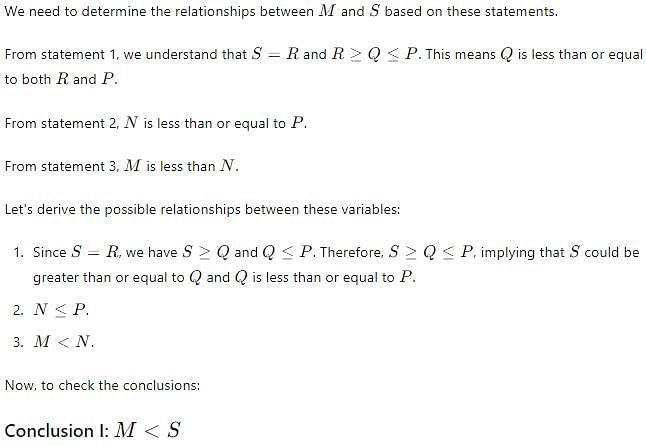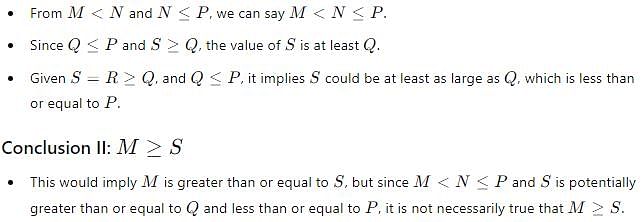Test: Inequalities - 2 - ACT MCQ
15 Questions MCQ Test Mathematics for ACT - Test: Inequalities - 2
A statement is given followed by two conclusions. Find which conclusion is true based on the given statement.
Statement:
C < A ≤ T = D ≥ O; G ≥ D < S; T ≥ A
Conclusions:
I: A ≤ O
II: C < G
Directions: In the following question assuming the given statements to be true, find out which of the following two conclusions definitely true.
Statements:
A ≤ P = B; C = P; F < B
Conclusions:
I. B < A
II. F = P
Directions: In the following question assuming the given statements to be true, find which of the given conclusions is definitely true.
Statement:
C < O > K; Z < R < N = C
If A + B = C + D and A + D > B + C, then which one of the following is definitely wrong?
In the given question, relationship between different elements is shown in the statement. The statement is followed by two conclusions. Study the conclusions based on the given statements and select the correct answer.
Statements:
U > H = G ≥ N; E < N > W ≥ O
Conclusion:
I. G > E
II. H > N
In the following question assuming the given statements to be True, find which of the conclusion among given conclusions is/are definitely true and then give your answers accordingly.
Statements:
Q > J ≥ M > L = K < S
Conclusions:
I. Q > L
II. J > K
III. L < S
Given below is an inequality, which of the following condition is TRUE?
If A > B > C > D = F ≥ G < H
Given below is an inequality, which of the following condition is TRUE?
If P > Q ≤ R = S ≥ T
Read the given statement and conclusions carefully. Assuming that the information given in the statements is true, even if it appears to be at variance with commonly known facts, decide which of the given conclusions is true based on the given statement.
Statement:
S = Q > R ≤ U = M > B
Conclusions:
I. Q > U
II. R < S
Given below is an inequality, which of the following condition is TRUE?
If P ≤ Q ≥ R; E ≥ Q; L < Q = D
In the following question, Few statements are given which are followed by some conclusions. According to the given statements, which conclusion is/are definitely true?
Statements:
M ≤ N = O ; M ≤ P ; O < Q
Conclusions:
I. Q > N
II. M ≥ O
In the following question, a statement is being followed by two conclusions. Find which of the two conclusion is/are true according to the given statement.
Statement:
J = K ≥ L > X ≥ Y ; J ≥ P ; P ≥ Z
Conclusions:
I: J < L
II: P ≤ Y
Assuming the given statements to be true in the following question , find which of the given conclusion is/are definitely true and then give your answers accordingly.
Statements:
V < Z ≥ Y ≥ X = A < B < C < D
Conclusions:
I. X < B
II. Y > A
III. V < Y
In the following question, Few statements are given which are followed by some conclusions. According to the given statements, which conclusion is/are definitely true?
Statements:
S = R ≥ Q ≤ P ; N ≤ P ; M < N
Conclusions:
I. M < S
II. M ≥ S
Solve problems using substitution (Mathematical Operations): If A > B, B > C and C > D, then which of the following conclusions is definitely wrong?
|
144 videos|100 docs|61 tests
|




















